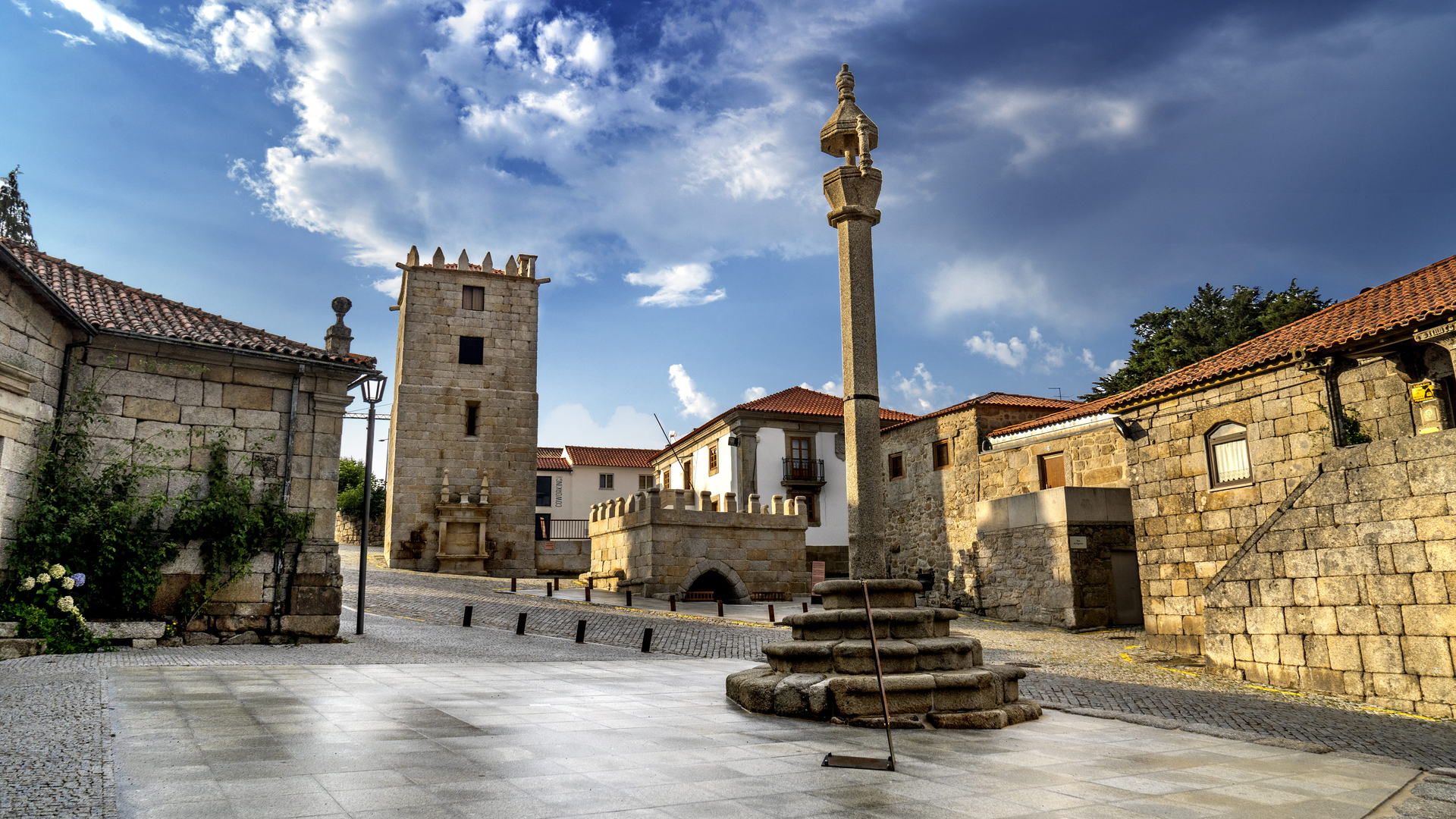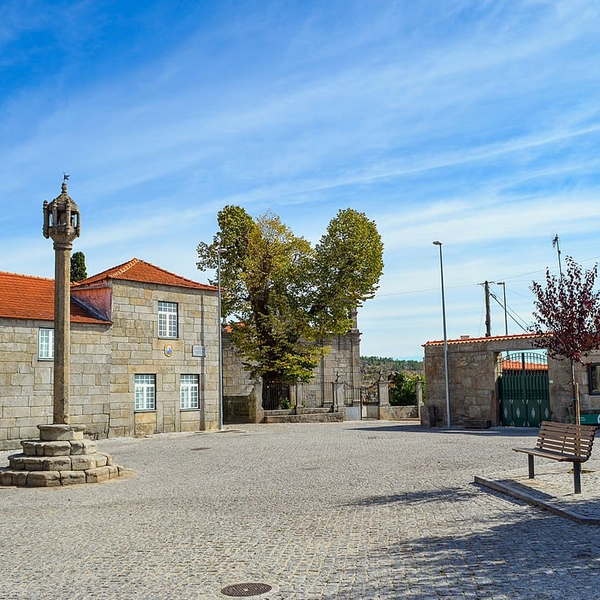
AGUIAR DA BEIRA
Exploring Aguiar da Beira, situated on a plateau at an altitude of over 700 metres between the Serra da Estrela and the Douro region, is a truly unique experience. The breathtaking landscapes, the abundance of natural resources and the distinctive ecosystems, especially the míscaro and the chestnut, together with the beauty of the waterways, including the springs of the Dão and Vouga Rivers, the presence of the Távora River and the grandeur of the Fumadinha reservoir, are irresistible elements for tourist, sports and leisure programmes.
The territory offers a journey through the historical evolution of the people's way of life and culture, with notable landmarks such as the Carapito Dolmen from the Neolithic period, sarcophagi, anthropomorphic graves and Chalcolithic hill forts such as the Castro de São Pedro dos Matos, Castro de Carapito and Castro das Abelhas.
Aguiar da Beira is a paradise for those who have yet to explore it, offering a serene environment that invites visitors to discover the wonders of nature, while immersing themselves in the cultural richness and traditions of the local community.
Traditional crops, such as Queijo da Serra cheese, chestnuts and potatoes, have a strong presence in local gastronomic fairs and restaurants, guaranteeing visitors a memorable experience.




Penaverde Pillory
HeritageThe Pillory of Pena Verde has been classified as a Property of Public Interest. King Sancho II granted Pena Verde a charter in 1240, confirmed in 1278 by King Dinis, and again by King Manuel in 1514. Pena Verde was a municipality until 1836, when it became part of the Municipality of Trancoso. In 1840 it became part of the municipality of Aguiar da Beira. It is this important history of the parish that the Pillory of Pena Verde represents today. It is a very simple monument that is generally accepted to have been erected in the 15th century, making it the oldest of the three pillories in the municipality of Aguiar da Beira.
Free visit.

Cabeço do Gato Viewpoint
HeritageLocated in Valagotes, in the parish of Forninhos, this viewpoint has a breathtaking view. At an altitude of over 600 metres, the landscape speaks for itself. The large patch of maritime pine, the vineyards on the horizon, 3 counties to admire at 360º where nature has the power to envelop us and convey all the calm and serenity of the place.
Free visit.
More information

Sanctuary of Our Lord of Castelinho
HeritageLocated in Ancinho, in the parish of Eirado. It was once a dwelling place for dozens of people; nowadays, those who own property there pass through.
Even though it has no fixed residents, it is never forgotten by the people who celebrate their devotion by going to this shrine to ask for graces.
Legend has it that a woman saw the image of the Crucified Lord among brambles and moss... In Ancinho it was found...
More information

Dolmen I of Carapito
HeritageThe Dolmen I of Carapito is one of the most emblematic and imposing megalithic monuments in the country, classified as a National Monument. Around 6,000 years ago, the ancestors built their majestic tombs there, with shafts up to 5 metres high. The mound has been restored and rebuilt and is known locally as ‘Casa da Moura’ (Moor's House), leading the population to have a close connection with the site and the legends associated with it.
Free visit.
More information

Source of the Dão River
HeritageThis important river in Portugal rises in Barranha, in the parish of Eirado. The source is on a plateau, but according to the people of the village, it gushes “a stream of water” that never runs dry. It runs in a north-east to south-west direction and crosses or borders several municipalities in the region. Near Ponte de Fagilde, 225m above the sea, the river becomes wild as it crosses an extensive crevasse with very steep slopes.
Free visit.
More information

Sanctuary of Nossa Senhora dos Verdes - Forninhos
HeritageThe Sanctuary of Nossa Senhora dos Verdes, classified as a Property of Public Interest, is a chapel of very simple architecture, probably built in the 17th century. It is decorated in a Joanine and Baroque style. Coffered ceiling in the nave and chancel and gilded carved altarpieces.
Devotion to Our Lady of the Green probably dates back to 1720 when a plague of locusts struck the region's fields and only disappeared thanks to the intervention of Our Lady.
More information

Historic Center of Aguiar da Beira
HeritageThe historic center of Aguiar da Beira is rich in heritage and history. In the central square you can see the beautiful Monumental Trilogy, unique in the country, where three national monuments structure a single space, the Largo dos Monumentos. This trilogy is made up of the Manueline Pillory, the Ameada Fountain and the Clock Tower.
The charm extends to the surroundings of this beautiful square, where you can see the Church of Misericórdia, the Chapel of Nossa Senhora do Leite and, at the highest point, the ruins of the Castle, which once served as a place of protection for the territory.
Free visit.
More information

Carapito Pillory
HeritageAccording to the enquiries of King Afonso III in 1258, the parish of Santa Maria de Carapito already existed. The parish is referred to as belonging to noble knights (villa de Carapito est de militibus), being served by royal judges, referring to the ‘municipality’, and it can be assumed that at that time Carapito already enjoyed privileges similar to those of a municipality, even though it didn't have a charter. The new charter creating the borough of Carapito was granted by King Manuel in 1514. The municipality was abolished in 1836 and incorporated into the municipality of Aguiar da Beira. It is the importance of this past that the Carapito Pillory represents today. A Manueline pillory can be seen in this beautiful square, and there are other identical pillories in the region, including the one in Aguiar da Beira, in the same municipality.
Free visit.
More information

Chapel of Our Lady of Fátima
HeritageThe Chapel of Our Lady of Fátima, built in Coruche in 1928, was the first to be built in mainland Portugal, after the Chapel of the Apparitions. The official authorization to worship Our Lady in Fátima was given in 1930, but only 11 years after the apparitions, this chapel was erected in Coruche, with a whole history associated with it and closely linked to devotion to Our Lady. Every year, in August, this parish dresses up for the festivities and venerates Our Lady of Fátima with devotion.





